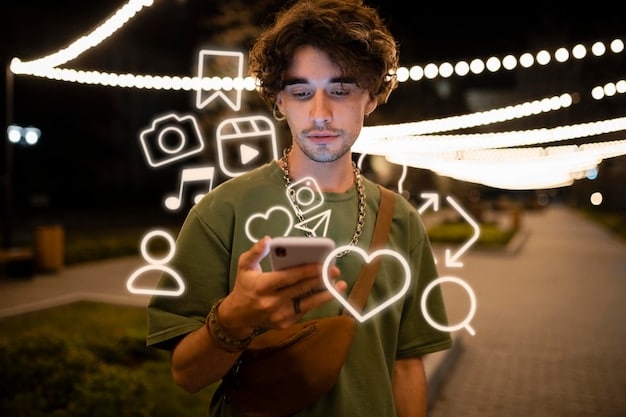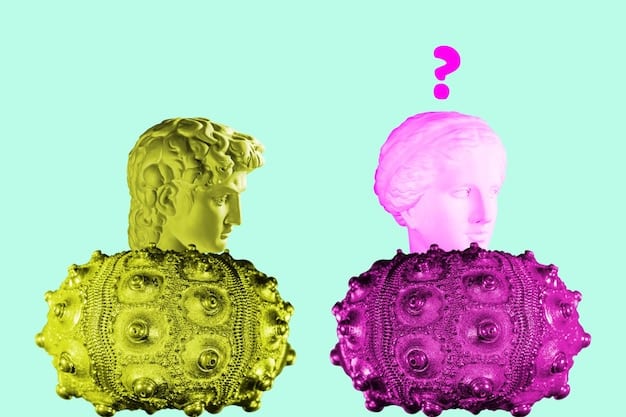The Attention Economy: Social Media’s Impact on Our Minds

Anúncios
The Attention Economy, intensified by social media, fundamentally reshapes how we focus, think, and interact by incentivizing platforms to capture and monetize our limited attention spans.
Anúncios
In today’s digital age, the attention economy: how social media is shaping our minds, is a critical topic. The platforms we use daily are not just connecting us; they are fundamentally altering how we process information, maintain focus, and engage with the world.
Understanding the Attention Economy
The attention economy is a concept that treats human attention as a scarce commodity. It posits that in an environment of information overload, capturing and retaining attention becomes a primary economic activity. This is especially true in the realm of social media.
Anúncios
Social media platforms thrive on user engagement. The more time users spend on these platforms, the more opportunities there are to display advertisements, collect data, and ultimately generate revenue. This dynamic creates an intense competition for our attention.
How Social Media Platforms Compete for Attention
Social media platforms employ various strategies to capture and hold user attention. These strategies often involve algorithms, content formats, and user interface designs that are optimized to maximize engagement.
- Algorithmic Feeds: Social media algorithms are designed to show users content that they are most likely to interact with, often prioritizing emotionally charged or sensational content.
- Infinite Scrolling: The infinite scrolling feature keeps users engaged by continuously providing new content without requiring them to actively navigate the platform.
- Notifications and Alerts: Notifications and alerts are used to draw users back to the platform, often creating a sense of urgency or fear of missing out (FOMO).
- Personalized Content: Platforms use data collected about users to create personalized content experiences that are tailored to their interests and preferences.

The competition for attention on social media is not merely about entertainment; it has profound implications for cognitive processes and behaviors. The constant bombardment of information can lead to attention fragmentation, reduced concentration spans, and an increased susceptibility to distraction.
The Impact of Social Media on Cognitive Processes
Social media’s impact on our cognitive processes is multifaceted. The way we consume, process, and remember information is being reshaped by the design and dynamics of social media platforms. This affects not only our ability to focus but also our critical thinking skills.
Frequent social media use is associated with a decrease in sustained attention spans. The constant switching between apps, notifications, and different types of content can make it difficult to maintain focus on a single task for an extended period.
Attention Fragmentation and Reduced Concentration
The fragmented nature of social media content contributes to attention fragmentation. Brief, visually stimulating content, such as short videos and images, dominates social media feeds. This constant stream of stimuli can train the brain to prefer short bursts of information over in-depth analysis.
Reduced concentration spans can affect various aspects of life, from academic performance to workplace productivity. When the brain is accustomed to constant stimulation, it becomes challenging to engage in activities that require sustained focus, such as reading or problem-solving.
Prolonged exposure to social media can alter the brain’s neural pathways, making it more susceptible to distraction. The instant gratification received from likes, comments, and shares can reinforce a preference for superficial engagement over deeper, more meaningful interactions.
The Role of Dopamine in Social Media Engagement
Dopamine, a neurotransmitter associated with pleasure and reward, plays a significant role in social media engagement. Social media platforms exploit the brain’s reward system to keep users coming back for more.
The anticipation of receiving likes, comments, or shares triggers the release of dopamine, creating a sense of pleasure and satisfaction. This positive reinforcement loop encourages users to continue engaging with the platform in the hope of receiving more rewards.
Social Validation and Reward Systems
Social validation is a powerful motivator on social media. The number of likes, comments, and followers a user has can influence their self-esteem and social status within the online community. This creates a system where users are incentivized to create content that will garner the most attention and validation.
The intermittent nature of rewards on social media makes them even more addictive. Users do not receive validation with every post, which creates a variable reward schedule that is highly effective in maintaining engagement.
- Variable Rewards: The unpredictable nature of likes and comments keeps users engaged.
- Social Comparison: Seeing others’ success can drive users to seek their own validation.
- Platform Design: Features like infinite scrolling ensure a constant stream of potential rewards.
The dopamine-driven reward system of social media can lead to compulsive behaviors and addiction. Users may find themselves spending hours on social media, neglecting other important aspects of their lives in pursuit of social validation.
The Impact on Mental Health
While social media can offer benefits such as social connection and access to information, excessive use has been linked to a range of mental health issues. The pressure to maintain an online persona, social comparison, and cyberbullying can all take a toll on mental well-being.
Studies have shown a correlation between heavy social media use and increased rates of anxiety and depression. The constant exposure to curated and often unrealistic portrayals of others’ lives can lead to feelings of inadequacy and low self-esteem.

Social Comparison and Self-Esteem
Social comparison is a natural human tendency, but it can be amplified on social media. Users are constantly exposed to carefully crafted images and narratives that highlight the positive aspects of others’ lives, leading to upward social comparisons that can negatively impact self-esteem.
The pressure to present a perfect online persona can be exhausting and contribute to feelings of anxiety and inadequacy. Users may feel the need to constantly compare themselves to others, leading to a cycle of negative self-talk and self-doubt.
- Curated Content: Seeing only the best parts of others’ lives can create unrealistic expectations.
- Online Persona: The pressure to maintain a perfect image can lead to anxiety.
- Cyberbullying: Online harassment can have severe and long-lasting effects.
Cyberbullying is another significant concern on social media. The anonymity and reach of online platforms can make it easier for individuals to engage in harmful behaviors, leading to emotional distress and mental health problems for victims.
Strategies for Managing Attention in the Digital Age
In an age dominated by the attention economy, it is crucial to develop strategies for managing our attention and reclaiming control over our cognitive processes. This involves being mindful of our social media use and implementing techniques to reduce distractions and improve focus.
One effective strategy is to limit the amount of time spent on social media platforms. Setting daily or weekly time limits can help users become more aware of their usage patterns and reduce their overall exposure to the attention-grabbing mechanisms of social media.
Mindfulness and Digital Detox
Mindfulness practices can help individuals become more aware of their thoughts and emotions, allowing them to make conscious choices about how they engage with technology. Practicing mindfulness can reduce the automatic and compulsive behaviors associated with social media use.
A digital detox involves intentionally abstaining from the use of digital devices for a set period. This can help individuals break free from the constant stimulation of social media and reconnect with their offline lives.
By practicing mindfulness and digital detox, individuals can regain control over their attention and reduce the negative impacts of the attention economy: how social media is shaping our minds in the modern digital age.
The Future of Attention and Social Media
As technology continues to evolve, the attention economy is likely to become even more pervasive. Understanding the dynamics of attention and developing strategies for managing it will be essential for navigating the digital landscape in the years to come.
One potential development is the rise of attention-aware technologies that are designed to help users manage their focus and reduce distractions. These technologies could include features such as adaptive notifications, personalized content filtering, and attention-training apps.
The future of social media may also involve a shift towards more mindful and intentional platforms that prioritize user well-being over engagement metrics. This could involve changes to platform design, content moderation policies, and business models.
- Attention-Aware Tech: Technologies that help manage focus and reduce distractions.
- Mindful Platforms: Social media that prioritizes user well-being.
- Ethical Design: Designing platforms that respect user agency.
By embracing ethical design principles and prioritizing user well-being, social media platforms can create more positive and sustainable relationships with their users. The future of attention in the digital age will depend on our ability to balance the benefits of technology with the need to protect our cognitive resources and mental health.
| Key Point | Brief Description |
|---|---|
| 🧠 Attention Economy | Treats attention as a scarce commodity. |
| 📱 Social Media’s Impact | Reshapes how we consume, process, and remember information. |
| Dopamine & Rewards | Drives engagement through social validation. |
| 🛡️ Managing Attention | Limit social media use, practice mindfulness. |
Frequently Asked Questions
▼
The attention economy is a concept that views human attention as a limited resource. In the digital age, where information is abundant, capturing and retaining attention becomes a primary goal for businesses and platforms.
▼
Social media platforms often employ techniques like infinite scrolling and personalized content to keep users engaged for longer periods. This constant stream of stimuli can lead to reduced attention spans and difficulty focusing on single tasks.
▼
Dopamine, a neurotransmitter associated with pleasure, is released when we receive positive feedback on social media, such as likes and comments. This creates a reward system that can make social media use addictive.
▼
Excessive social media use has been linked to mental health issues such as anxiety, depression, and decreased self-esteem. Social comparison and cyberbullying can contribute to these negative effects.
▼
Strategies for managing attention include setting time limits for social media use, practicing mindfulness, and taking digital detox periods. These actions help to reduce distractions and improve focus and overall well-being.
Conclusion
In conclusion, the attention economy: how social media is shaping our minds is profoundly impacting cognitive processes and mental health. By understanding the dynamics of attention and implementing strategies for mindful engagement, individuals can navigate the digital landscape more effectively, protecting their focus and well-being.





